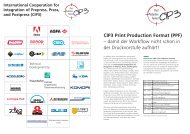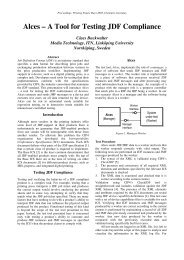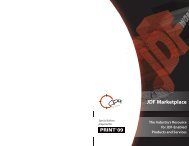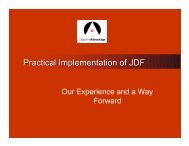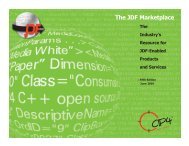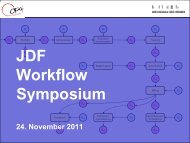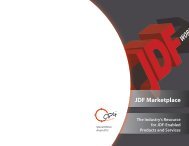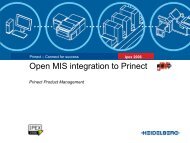Create successful ePaper yourself
Turn your PDF publications into a flip-book with our unique Google optimized e-Paper software.
Master Project at Nada Evelina Thunell<br />
• Query support, controllers that support queries respond to requests from other<br />
controllers by communicating their status.<br />
• Command support, if a controller supports this level of messaging it has the<br />
ability to process commands. <strong>The</strong> controller can receive commands to<br />
interrupt a job, restart a job or to change status of a job in a queue.<br />
• Submission support, this is the highest level of messaging. A controller that<br />
has submission support can accept a <strong>JDF</strong> job via an http post request to the<br />
messaging channel. [1]<br />
<strong>The</strong> sending controller creates a JMF message. A JMF file with a message of the<br />
message family Response is available in Appendix B.<br />
3.1.8 <strong>JDF</strong> Extensibility<br />
One of the main benefits of <strong>JDF</strong> is the flexibility it supplies through its extensibility.<br />
Extensibility means that a vendor can add their own elements etc. to their application in<br />
order for it to include all data needed. <strong>The</strong>se so-called private extensions are<br />
implemented by using XML namespaces. Private extensions that have become widely<br />
used are in the future intended to be included in the next version of the specification.<br />
3.1.9 <strong>The</strong> <strong>JDF</strong> Workflow<br />
A <strong>JDF</strong> job is normally created by one agent and is then modified by other agents during<br />
execution. A job is modified during execution, for example will the status of a process<br />
or the availability of a resource change.<br />
A controller can route the <strong>JDF</strong> job first when all input resources and parameters of a<br />
node in that very job, are available. <strong>The</strong> controller routes it to a device, which will<br />
execute the process. After the process is completed, the agent or controller will modify<br />
the node to record the results of the process, as shown in Figure 3.5 and 3.6.<br />
<br />
…<br />
<br />
<br />
<br />
<br />
Figure 3.5 <strong>The</strong> file before modification by the agent [1]<br />
<br />
…<br />
<br />
<br />
<br />
<br />
<br />
<br />
<br />
<br />
<br />
Figure 3.6 Code after modification by the agent [1]<br />
10




